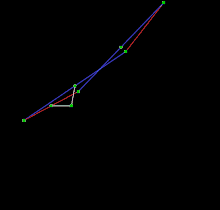Hart's inversor
Hart's inversor is one of two mechanisms that provides a perfect straight line motion without sliding guides.[1] They were invented and published by Harry Hart in 1874–5.[1][2]

Hart's (first) inversor. Links of the same color are the same length. The relative position of the fixed point, the input, and the output along their links is the same (half, here).

Hart's A-frame, or Hart's second inversor. The short links are half the length of the long ones. The center link is one quarter of the way down the long links. A fixed link along the bottom of the same length as the long links is not shown.
Hart's first inversor is based on an antiparallelogram. The addition of fixed points and a driving arm make it a 6-bar linkage. It can be used to convert rotary motion to a perfect straight line by fixing a point on one short link and driving a point on another link in a circular arc.[1][3]
Hart's second inversor, also known as Hart's A-frame, is less flexible in its dimensions, but has the useful property that the motion perpendicularly bisects the fixed base points.
Example dimensions

- AB = AC = BD = 4
- CE = ED = 2
- Af = Bg = 3
- fC = gD = 1
- fg = 2
.png)
- AB = Bg = 2
- CE = FD = 6
- CA = AE = 3
- CD = EF = 12
- Cp = pD = Eg = gF = 6
See also
- Straight line mechanism
- Four-bar linkage
- Quadruplane inversor a generalization of Hart's first inversor
References
- "True straight-line linkages having a rectlinear translating bar" (PDF).
- Ceccarelli, Marco (23 November 2007). International Symposium on History of Machines and Mechanisms. ISBN 9781402022043.
- "Harts inversor (Has draggable animation)".
External links
| Wikimedia Commons has media related to Hart's inversor. |
- bham.ac.uk – Hart's A-frame (draggable animation) 6-bar linkage
This article is issued from Wikipedia. The text is licensed under Creative Commons - Attribution - Sharealike. Additional terms may apply for the media files.